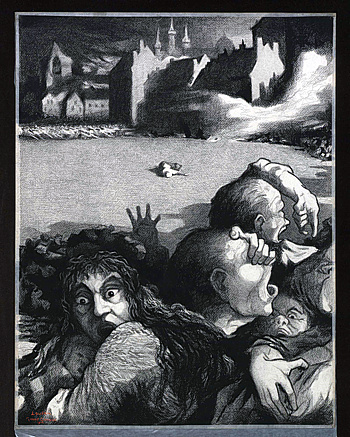Paul
Gough
'Mayhem and Madness: the Art of War'
Commissioned by The Art Newspaper,
International Edition, Issue 261, October
2014
It is a dreadfully familiar image of mayhem
and madness: a foreground crammed with wildly gesturing fleeing
figures, their hands clasped across distraught faces, eyes
bulging with urgent fear. Behind this convulsing crowd a city
burns. Swathes of smoke obscure the detail, but the sky is
underlit by fires, buildings seem ready to topple. Indistinct
crowds gather amongst the wreckage: are they fleeing civilians
or the rampaging enemy? It matters little, because we are
drawn inevitably to the prone figure in the mid-distance,
a townswoman caught in the no-man’s-land between extreme
danger and dubious safety. It is the only moment of stasis
in the entire composition, the rest of the image pulls us
from left to right and back again. Yet despite the movement,
the fleeing crowd seem locked into the frame; there will be
no escape.
This remarkable lithograph is the work of Gisbert Combaz (1869-1941),
a Belgian lawyer, artist and professor in the decorative arts
who designed book covers and furniture but is best known for
his posters, which typify the voluptuous flowing rhythms of
Art Nouveau. Although his name might be obscure, his posters
are instantly memorable and he is one of very few poster artists
from La Belle Epoch
to create a personal style and pictorial language that is
recognisable today.
The destruction of Louvain was one of the first momentous
violations of the Great War. Only weeks after the outbreak
of the conflict and after a terrible massacre in the village
of Dinant, the invading German army chose to punish the plucky
resistance of the Belgian army by systematically looting and
burning Louvain, including its renowned university and ancient
library founded in 1426. Under the appalled gaze of the international
community, the German Embassy in USA actually confirmed the
massacre in a chilling wireless statement from Berlin: ‘Louvain
was punished by the destruction of the city.’ Outraged
and distraught, artists across the world, including many Belgians
like Combaz responded with fierce condemnation and powerful
images that resonate today.
Gisbert Combaz (1869-1941)
‘Louvain’,
1916, Koninlijke Bibliothhek van Belgie [Bibliotheque Royale
de Belgique]
With thanks and credit to: www.theartnewspaper.com/issues
|
|
|


